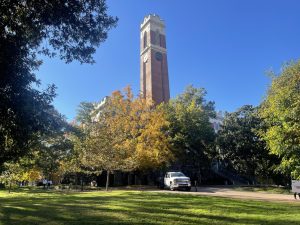From front-row seats during the Civil War to a seeping reputation as a “Harvard of The South,” Vanderbilt University has long stood as an icon within Southern culture ever since its creation. The “All That Glitters” exhibit currently in the Vanderbilt Special Collections Library stands as a testament to this rich history. Located at 1101 19th Avenue South, the exhibit sits within a short walking distance of the campus making it an excellent reason to visit until its closure on June 30. The collection contains a variety of artifacts donated or collected by the University, ranging from a 24-karat miniature house to academic awards for a variety of achievements.
The Ceremonial Mace
The mace, carried by the Chair of the Faculty Senate, is used as a symbol of authority for Vanderbilt to provide degrees. First used in June of 1969, the mace holds a treasure-trove of Vanderbilt symbolism on it. The rear panels depict leaves from a Southern Magnolia, a staple of Vanderbilt’s campus landscape that is often in full bloom when commencement occurs. The dark rosewood shaft of the mace is a backdrop of golden oak leaves alongside shields. The oak leaf was chosen due to its presence on the Vanderbilt family’s coat of arms. The shields are designed to resemble the top of the Kirkland Hall tower, highlighting the importance of Vanderbilt’s first lecture hall. The “knocker,” or end of the mace, is designed to resemble a magnolia acorn.
The creator, Norah Creswick, is a Scottish artist-jeweler typically known for her craftsmanship of spoons and smaller pendants. This makes the Vanderbilt ceremonial mace incredibly special, being one of few grander examples of Creswick’s craftsmanship.
Historical Hallmarks
Often being used to identify the craftsmanship and purity of metalwork, hallmarks are often seen in fine jewelry throughout the world. Another place one can find these hallmarks is on fine cutlery such as the ones on exhibit. From a spoon forged to celebrate a wedding in 1671 to a mid-20th century tea strainer, the wealthiest of society have been using their dinnerware as a symbol of their wealth; that wealth now is exhibited through the display case housing some of the finest silver goods of these families. These pieces were all donated by the original owners into the hands of Vanderbilt University throughout the years, perhaps highlighting the families that have tossed their caps at Vanderbilt.
My favorite of the dinnerware was the sterling silver tea caddy developed by the Bateman family. At the time of development, the Bateman family was ruled by the children of Hester Bateman, one of the most influential silversmiths of her time in Great Britain. Bateman developed silverware for King George Ⅲ during her lifetime, making the tea caddy developed by her children a special piece for the exhibit. As seen on the tea caddy, the Bateman family was famous for their use of bright engravings to accentuate the details placed on their work.
Golden Achievements
In the world of academia, it can be argued that the Nobel Prize is one of the most prestigious awards for any scholar to receive, with Vanderbilt being affiliated with six. On exhibit, the Nobel Prize in Medicine and Physiology proudly sits, awarded to Dr. Earl W. Sutherland Jr. in 1971 for his work in understanding the workings of hormones in the human body. His discovery of cyclic adenosine phosphate awarded him the prize shortly before his passing, resulting in the prize acting as a memorial to his service in the sciences.
Another notable set of awards on display are the Phi Beta Kappa and Omicron Delta Kappa keys. In recognition of outstanding achievement within each respective organization these early awards were donated by alumni to Vanderbilt University, highlighting the recognition of achievement. Considered one of the greatest undergraduate achievements, the exhibit also houses a 1915 Founder’s Medal. Still being awarded today, the Founder’s Medal distinguishes the graduate with first honors in each of Vanderbilt’s colleges. On the head of the medal, it displays a portrait of Cornelius Vanderbilt. In fact, Vanderbilt himself distributed the award in the early years of the university, with the medal being a replica of the Congressional Medal won by the commodore during the Civil War.
Shining Silvers
With a history as rich as Vanderbilt’s, it’s par for the course to accumulate trinkets along the way. The silver charm bracelet is a notable inclusion of this, being awarded every year from 1928 to 1976 by the female peers of the recipient. Once the recipient is chosen, her name will be engraved on a charm to be placed on the bracelet, acting as a symbol of the history of female achievement for much of Vanderbilt’s 20th-century history. Another memento of notable figures includes a brooch with a portrait of Dr. Martin Luther King Jr. distributed by the Southern Leadership Conference in 1968, the portrait of King swivels to reveal an excerpt from his famous “I Have A Dream” speech. The piece was created after the assassination of King, in remembrance of the Southern Civil Rights icon for his work in desegregating the South. It can suffice to say that Vanderbilt would be a much different place without Dr. King’s work, making the piece valued in the exhibit.
Unearthed approximately a year ago, the 1874 time capsule located by Kirkland Hall revealed history’s fifty cents. While having a low face value today, the historical significance of the 1861 silver half-dollar traces back to its mint in New Orleans. This coin is considered special due to it being minted shortly before Louisiana’s succession from the Union in that same year. This makes the coin incredibly special due to its rarity alongside its historical significance towards the history of Vanderbilt University in the Reconstruction era.
Reading In The History Books
The two books on display include “Friendship: An Essay by Ralph Emerson” and Quiller-Couch’s “Oxford Book of English Verse.” Both books include extensive pages of poetry, with Quiller-Couch publishing a second book in the series in 1939. The book is adorned in silver linings with a blue silk cover that allows the book to shine in the exhibition case. “Friendship: An Essay” also highlights such respect for the book by its cover’s designer. This is shown with the gold-adorned cover featuring various hearts, symbolizing the uniting topic of friendship among the poetry. Both books were provided for exhibit courtesy of the Nettie Hale Rand Collection of Fine Binding and Printing.























